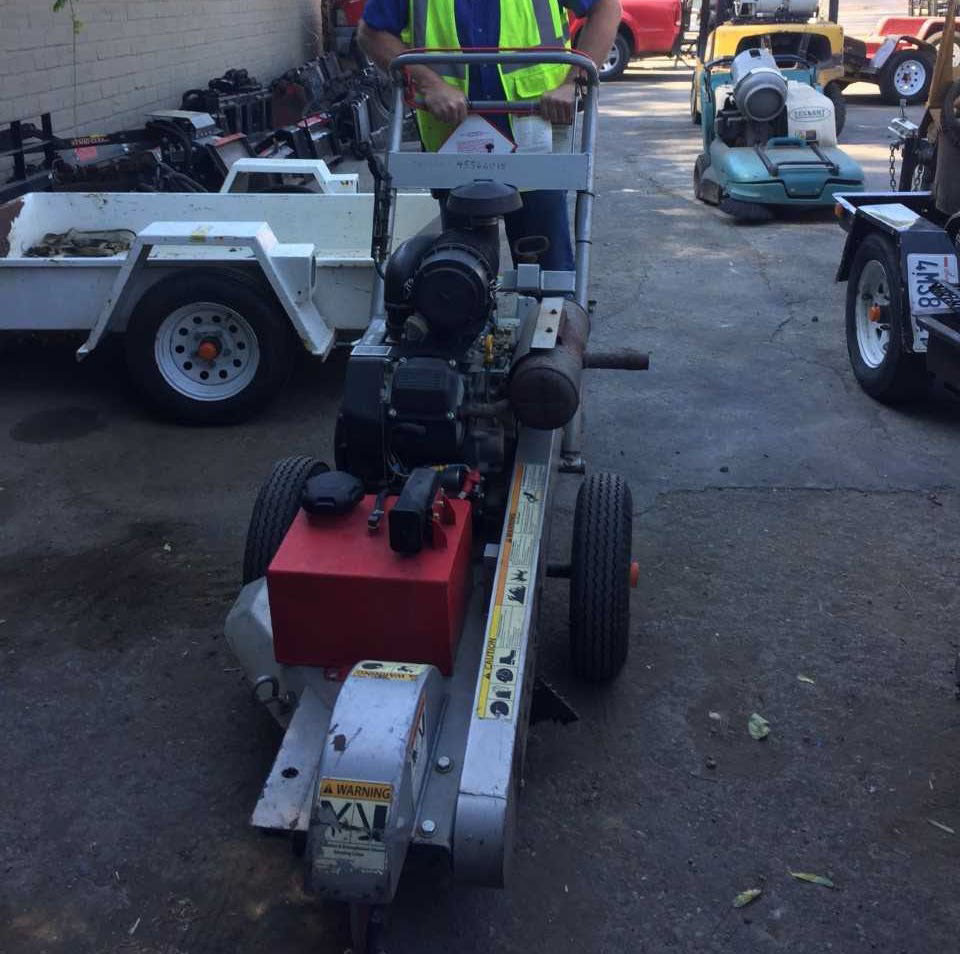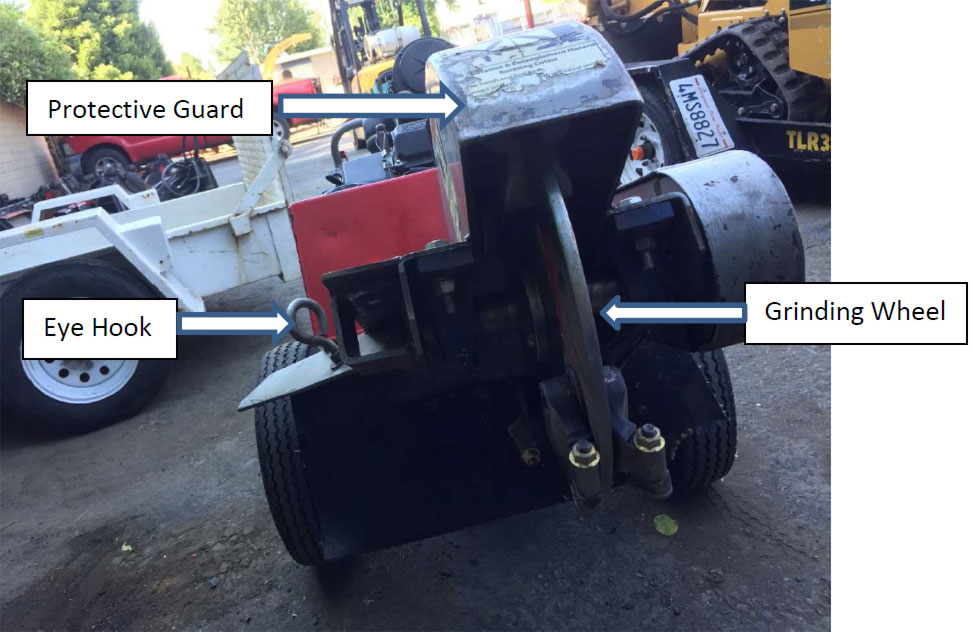Case Report: 18CA002
Laborer dies when he is pulled into a tree stump grinder
Download a PDF to print this report:
Laborer dies when he is pulled into a tree stump grinder (18CA002, PDF)
Summary
A laborer working for a landscaping company died when he was pulled into a tree stump grinder. The victim was helping the landscaping company owner (stump grinder operator) guide the machine by pulling on a rope tied around his waist and attached to the stump grinder. The rope caught in the stump grinder's grinding wheel and pulled the victim into its rotating motion. The CA/FACE investigator determined that, in order to prevent similar future incidents, landscaping companies should:
- Ensure that workers who operate stump grinders are trained on and consistently follow safety policies and procedures.
In addition,
- Homeowners who need tree stumps removed should only hire landscapers who are certified by organizations such as the Tree Care Industry Association (TCIA) or the International Society of Arboriculture (ISA).
Introduction
On April 9, 2018, at approximately 11:30 a.m., a 66-year-old Hispanic male laborer suffered fatal injuries while assisting a landscaping company owner who was operating a stump grinder. The CA/FACE investigator received notification of this incident on April 17, 2018, from the Division of Occupational Safety and Health (Cal/OSHA) Weekly Fatality Report. On April 30, 2018, contact was made with the owner who was involved in this incident. On May 10, 2018, the CA/FACE investigator and an industrial hygienist traveled to the incident scene and interviewed neighbors across the street from the incident site who had witnessed the event. Another landscaping company employee who was at the incident site finishing the project was also interviewed. Later that same day, the owner involved in the incident was interviewed at his residence. Incident reports from the county coroner, fire department, and sheriff's department were obtained and reviewed.
Employer
The employer of the victim was a family-owned and operated landscaping company that has been in business for over 20 years. According to the owner, he was the sole employee of the business. The employer occasionally hired the victim to help him with landscaping jobs. The employer spoke Spanish as his primary language, but also spoke and understood English.
Written Safety Programs and Training
The landscaping company did not have a written safety or Injury and Illness Prevention Program (IIPP) or any other safety documentation required by law. Neither the owner nor the victim had received formal training on the operation of stump grinders. Previously, they were provided with brief general instructions about stump grinder operation from the tool rental companies, but no specific instructions were given in this incident. The company owner was not trained in first aid or CPR.
Worker Information
The victim was a 66-year-old Hispanic male laborer who was a relative of the owner and had been working sporadically with him for about six months. The victim had performed varied landscaping tasks, including stump grinder operation. It is unknown if he had used the machine involved in this incident in the past. The victim was born in Peru and his primary language was Spanish, although the owner stated the victim also spoke and understood English.
Incident Scene
The incident scene was a private residence located on a short cul-de-sac street. The residence was a two-story home with an attached garage. The front of the house faced east and the back faced west. The tree involved in this incident was an approximately 50-foot sycamore in the front yard of the residence. Sycamore trees can grow to a height of 40 to 100 feet with a spread of 40 to 70 feet at maturity. Sycamores are often divided near the ground into a massive trunk with an aggressive root system that can be difficult to remove.
Stump Grinder
A stump grinder is a power tool that removes tree stumps by means of a rotating grinding wheel with carbon steel teeth that chips away the wood. Stump grinders can be the size of a lawn mower or as large as a truck. Most accomplish their task by means of a high-speed disk cutter wheel with fixed carbon steel teeth that grinds the stump and roots into small chips. The grinding wheel movements are controlled by hydraulic cylinders that push the wheel laterally, and up and down, through the stump. Stump grinding is generally performed by a trained arborist or landscaper, but the machine may be rented by anyone from tool rental companies. The manufacturer's instruction manual warns against allowing additional workers within 75 feet while grinding. There are various types of stump grinders, some of which are larger and could have better reached the stump and roots involved in this incident. If a stump grinder needs to be used to reach the roots below ground, a thorough job assessment should be performed to determine the proper machine that can reach the roots from above.
Weather
The weather on the day of the incident was partly cloudy and overcast with a slight breeze of 7 mph and an average temperature of 65 degrees F.
Investigation
Prior to the day of the incident, the landscaping company owner was hired by the homeowner to remove the sycamore tree, stump, and roots in the front yard. The owner hired the victim to assist him with this job and rented a large stump grinder from a nearby tool rental company. They removed the major section of the sycamore tree stump and portion of the roots, but a portion of the stump and smaller roots remained below ground and could not be reached by the large stump grinder. The owner then returned the large stump grinder to the rental agency and rented a smaller stump grinder (Exhibits 1 and
2) that could be lowered below ground to reach the roots.
The rental agency manager stated that he did not ask the owner about his knowledge of the small stump grinder operation, as he was a frequent customer who had rented stump grinding and other landscaping machines from them many times in the past – including the model involved in this incident. The rental agency manager stated that the owner did not ask for, and was not given, the stump grinder instruction manual.
On the day of the incident, the owner and the victim attached a rope to an eye hook on the disc guard of the stump grinder (Exhibit 2) to help lower the machine below ground level to grind the stump and roots. The rope was not removed from the machine. The victim tied the rope around his waist, then pulled and leaned backward to help maneuver the grinding wheel while the owner was operating the stump grinder. A neighbor from across the street stated the victim was standing near the edge of the stump cavity. As the grinder was operating, the rope likely became slack and then caught around the grinding wheel, pulling the victim headfirst into the rotating disc.
The neighbor witnessed the victim suddenly lunge forward headfirst into the hole. She immediately went to provide assistance while another neighbor called 911. The paramedics and fire department arrived at the incident scene within minutes. The victim was transported to a local hospital for treatment and died the next day from his injuries.
Cause of Death
The cause of death, according to the death certificate, was blunt force head injury.
Recommendations
The CA/FACE investigator determined that, in order to prevent similar future incidents, landscaping companies should:
Recommendation #1: Ensure that workers who operate stump grinders are trained on and consistently follow safety policies and procedures.
Discussion: In this incident, the victim tied a rope to the stump grinder near the grinding wheel in order to guide the machine, a procedure that placed him at risk for entanglement and severe injury or death. Operators of stump grinders should be trained on the general principles of stump removal and on the specific operation of the stump grinder they are using. The following are important safety precautions for operators to note before using a stump grinder:
- Check for debris and buried objects before positioning the stump grinder, making sure the machine is stable.
- Ensure the operator has good footing and a clear path to exit the work area.
- If working on a slope, position the machine and operator below the stump on the downhill side. However, operators should avoid working on steep slopes.
- Be mindful of surroundings to ensure there will not be property damage or injury to persons if debris is thrown from the machine.
- When possible, use a barrier to repel any debris from the cutting action.
- Only the operator should be present during stump grinding operation. Ensure no other people are within 75 feet while operating the stump grinder.
- Never modify or alter the stump grinder in any way.
In addition, safety training should warn of the risk of entanglement when tying ropes or chains to a stump grinder. The operator and any worker who assists in the operation of a stump grinder should understand that ropes or chains should never be attached to a stump grinder while it is in operation. An eyehook or other attachment point should only be used for moving the machine (when off) and not for attachment of ropes or chains during operation.
With appropriate training, the victim may have recognized that tying a rope to the stump grinder was not a safe work practice. If he had not attached the rope to maneuver the stump grinder, he would not have become entangled and this incident could have been prevented.
Recommendation #2: Homeowners who need tree stumps removed should hire only landscapers who are certified by organizations such as the Tree Care Industry Association (TCIA) or the International Society of Arboriculture (ISA).
Discussion: In this incident, the homeowner hired a landscaping company that did not have a certified arborist or certified tree worker on staff. Stump grinding is an extremely dangerous process and should only be done by trained arborists or tree workers who can operate equipment safely. Trained arborists or tree workers are more likely to ensure that that their employees are well supervised and trained, thereby minimizing the risk of injury during stump grinding operations. A trained arborist or tree worker would have performed a thorough job inspection to determine the proper machine to be used, such as a stump grinder with extended reach – thereby preventing the use of a smaller machine that could not controlled below ground. In addition, if the victim had been supervised by a certified arborist or tree worker, he likely would not have tied a rope or been within 75 feet of the machine.
Exhibits

Exhibit 1. The stump grinder used in this incident.

Exhibit 2. A front view of the stump grinder used in this incident, showing the grinding wheel and protective guard covering the wheel.
References
Instructions for Operation, Maintenance (PDF) - Stump and Root Grinder Owner's Manual
Stump Grinder Reminder (PDF) - Tree Care Industry Association
California Code of Regulations, Title 8, Subchapter 7, General Industry Safety Orders, Group 3.
Tree Work, Maintenance or Removal - §3421 General - §3427 Safe Work Procedures -§3428. Stump Cutters
Authors
Hank Cierpich, FACE Investigator
Robert Harrison, MD, MPH, FACE Project Officer
Laura Styles, MPH, Research Scientist
March 25, 2019